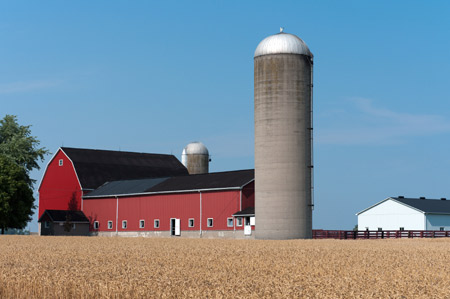 (The Seattle Times)– In a year of record agricultural earnings in the U.S., Steve Ruh spent a chunk of his income to build what’s become an increasingly common sight at farms across the Midwest — grain-storage bins.
(The Seattle Times)– In a year of record agricultural earnings in the U.S., Steve Ruh spent a chunk of his income to build what’s become an increasingly common sight at farms across the Midwest — grain-storage bins.
The Illinois corn grower started with 250,000 bushels of storage capacity in 2009 and added 100,000 this year to avoid wasting precious harvest time in line at grain elevators. He can now hold crops during gluts, hoping to sell at higher prices when grain is scarcer, and is storing half the 400,000-bushel corn crop this season at his farm in Sugar Grove.
“I like the control,” said the 42-year-old, who works 3,000 acres of corn, soybeans, wheat and alfalfa. “This allows me to market 12 months out of the year instead of half that time.”
Corn Belt farmers like Ruh have pushed up U.S. oilseed- and grain-storage capacity to the highest in two decades.
“We are looking for 2012 to be a huge demand for storage,” said Doug Niemeyer, a general manager at Brock Grain Systems, which is controlled by Warren Buffett’s Berkshire Hathaway.
U.S. farmers, whose crop futures trade in Chicago and help set global grain costs, are gaining pricing power as the world shifts from grain surpluses to deficits, according to David Nelson, a global strategist in Chicago for Rabobank.
“The increase in on-farm storage plus stronger farmer balance sheets has shifted power upstream toward the farmer,” said Nelson. ”
World corn reserves measured before the start of 2012 harvests in the Northern Hemisphere will fall to a five-year low, and U.S. inventories on Aug. 31 are forecast to fall to the lowest since 1996, according to the U.S. Department of Agriculture.
The shift raised prices for buyers, including Cargill, Archer Daniels Midland (ADM) and Bunge during the harvest that ran from September through December.
On-farm storage for grains and oilseeds in the U.S. climbed to 12.5 billion bushels last December, the most since 1989, according to the latest department estimates. Bin makers GSI and Brock say farmers are still adding more storage.
In Decatur, Ill. — ADM’s hometown and a U.S. corn- processing center — buyers of the grain paid an average premium of 18.2 cents a bushel above the Chicago futures price to take delivery of corn in October, the most in at least four years, Bloomberg data show. Premiums paid by export terminals near New Orleans for corn have jumped 7.2 percent in the past year and are 52 percent higher than the average from 2007 to 2010, according to USDA data.
The processors “are having to bid up corn to get corn out of someone’s hand, the farmer or elevator,” said Tim Lenz, who farms 2,600 acres of corn, soybeans and wheat in Strasburg, Illinois.
Lenz is holding 60 percent of his corn crop in his bins, up from 40 percent a decade ago, when he first added storage. “It’s not going to allow them to get cheap corn at the glut of harvest,” he said.
While storage bins help farmers wait out low prices, the growers have to contend with timing sales amid volatility, Lenz said.
“It’s a tricky decision for farmers to own storage,” said Bunge Chief Executive Alberto Weisser. “It only makes sense for very large farmers.”
ADM and Cargill declined to comment on the impact expansion in farm storage is having on grain prices.
Cargill has been increasing its own storage because eventually grain has to move to the traders and processors for sale domestically and overseas, said Mark Klein, a spokesman for the Minneapolis-based company. Commercial storage held by companies has risen to a record 9.74 billion bushels, USDA data shows.
Cargill six years ago introduced a service to help build bins for farmers who contract to sell it grain, Klein said.
Illinois farmer Gary Schmalshof said he sold corn to Cargill for $7.40 a bushel in September, up from $6 a year earlier.
“They were afraid that corn would go into the bins and they couldn’t access it,” said Schmalshof, who’s storing 70 percent of his 550,000-bushel harvest.
The combined storage capability of U.S. farmers and companies has expanded after 2004 as the corn crop ballooned to meet greater demand from the ethanol industry. Now, even as U.S. grain harvests shrink, farmers are still adding more bins.
Consolidation among U.S. farms is also a contributor to demand, said Brock’s Niemeyer.
The average new bin has more than doubled in size to as much as 35,000 bushels in two decades, according to Assumption, Ill.-based GSI.
Terry Jones, a farmer of corn and soybeans on 10,500 acres in Iowa and Oklahoma, says corn can rise by as much as $1 a bushel between the end of the harvest and the next summer. He’s focused more on storage than buying land the last two years and has built ties with livestock producers and ethanol mills.
“I like it when they call me because we know we are going to get a good price for our corn,” Jones said.




